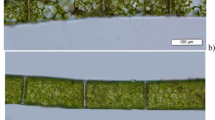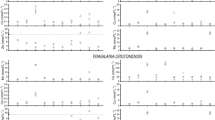Abstract
Effects of zinc on growth, cell morphology, oxidative stress responses and zinc removal activity of two common phytoplankton species, Monoraphidium pusillum (Printz) Komárková-Legnerová and Monoraphidium griffithii (Berkeley) Komárková-Legnerová were investigated at a concentration range of 0.2–160 mg l−1 zinc. Cell densities and chlorophyll content decreased compared with controls in cultures of both species, effective concentrations causing 50 % growth inhibition within 72 h on the basis of cell numbers were 33.69 and 25.63 mg l−1 zinc for M. pusillum and M. griffithii, respectively. Changes in cell morphology and elevated lipid peroxidation levels appeared in zinc-treated cultures of both species, but only at higher (>10 mg l−1) zinc concentrations. The most effective zinc removal appeared at 20 and 10 mg l−1 zinc concentration for M. pusillum and M. griffithii, respectively. Removed zinc is mainly bound on the cell surface in the case of both species. This study provides new data for the zinc tolerance and zinc removal ability of the green algae M. pusillum and M. griffithii and shows that green algal species common in surface waters could have zinc tolerance and zinc-binding abilities, which makes them feasible in treatment of waters contaminated with 10–20 mg l−1 zinc.





Similar content being viewed by others
References
Ahuja P, Gupta R, Saxena RK (1999) Zn2+ biosorption by Oscillatoria angustissima. Proc Biochem 34:77–85
Ahuja P, Mohapatra H, Saxena RK, Gupta R (2001) Reduced uptake as a mechanism of zinc tolerance in Oscillatoria angustissima. Curr Microbiol 43:305–310
Andrade LR, Farina M, Amado-Filho GM (2004) Effects of copper on Enteromorpha flexuosa (Chlorophyta) in vitro. Ecotoxicol Environ Saf 58:117–125
Bates SS, Tessier A, Campbell PGC, Buffle J (1982) Zinc adsorption and transport by Chlamydomonas variabilis and Scenedesmus subspicatus (Chlorophyceae) grown in semicontinuous culture. J Phycol 18:521–529
Bird G, Brewer PA, Macklin MG, Balteanu D, Driga B, Serban M, Zaharia S (2003) The solid state partitioning of contaminant metals and As in river channel sediments of the mining affected Tisa drainage basin, northwestern Romania and eastern Hungary. Appl Geochem 18:1583–1595
Brinza L, Dring MJ, Gavrilescu M (2007) Marine micro- and macro-algal species as biosorbents for heavy metals. Environ Eng Manag J 6:237–251
Broadley MR, White PJ, Hammond JP, Zelko I, Lux A (2007) Zinc in plants. New Phytol 173:677–702
Chojnacka K (2010) Biosorption and bioaccumulation—the prospects for practical applications. Environ Int 36:299–307
Cobbett C, Goldsbrough P (2002) Phytochelatin and metallothioneins: roles in heavy metal detoxification and homeostasis. Annu Rev Plant Biol 53:159–182
Cotton FA, Wilkinson G, Murillo CA, Bochmann M (1999) Advanced inorganic chemistry, 6th edn. John Wiley & Sons Inc., New York
Das N (2010) Recovery of precious metals through biosorption—a review. Hydrometallurgy 103:180–189
de Bashan LE, Bashan Y (2010) Immobilized microalgae for removing pollutants: review of practical aspects. Bioresource Technol 101:1611–1627
de Queiroz JC, de Melo Ferreira AC, da Costa ACA (2012) The growth of Monoraphidium sp. and Scenedesmus sp. cells in the presence of thorium. Sci World J. doi:10.1100/2012/592721
Eisler R (1993) Zinc hazard to fish, wildlife, and invertebrates: a synoptic review. Contam Hazard Rev 10:1–126
Felföldy L (1987) A biológiai vízminősítés. 4. kiad. In: Vízügyi Hidrobiológia 16. VGI, Budapest, 258
Fosmire GJ (1990) Zinc toxicity. Am J Clin Nutr 51:225
Fujii K, Nakashima H, Hashidzume Y, Uchiyama T, Mishiro K, Kadota Y (2009) Nutritional profile of Monoraphidium sp. GK12, astaxanthin-producing microalga, and its energy-saving outdoor cultivation. J Biosci Bioeng 108(1):S44
Fukami M (1988) Effects of zinc on metal metabolism on the zinc tolerant chlorotic mutants of Euglena gracilis. J Agric Biol Chem 52:2343–2344
Gattullo CE, Bährs H, Steinberg CEW, Loffredo E (2012) Removal of bisphenol A by the freshwater green alga Monoraphidium braunii and the role of natural organic matter. Sci Total Environ 416:501–506
Gold C, Feurtet-Mazel A, Coste M, Boudou A (2003) Impacts of Cd and Zn on the development of periphytic diatom communities in artificial streams located along a river pollution gradient. Arch Environ Contam Toxicol 44:189–197
Hammer Ř, Harper DAT, Ryan PD (2001) PAST: paleontological statistics software package for education and data analysis. Palaeontol Electron 4:9
Hassler CS, Behra R, Wilkinson KJ (2005) Impact of zinc acclimation on bioaccumulation and homeostasis in Chlorella kesslerii. Aquat Toxicol 74:139–149
Hornstrom E, Harbom A, Edberg F, Andren C (1995) The influence of pH on aluminium toxicity in the phytoplankton species Monoraphidium dybowskii and M. griffithii. Water Air Soil Poll 85(2):817–822
Horváth B, Gruiz K (1996) Impact of metalliferous ore mining activity on the environment in Gyongyosoroszi, Hungary. Sci Total Environ 184:215–227
Hussein H, Farag SI, Kamal K, Moawad H (2004) Biosorption of heavy metals from waste water using Pseudomonas sp. Electron J Biotechnol 7(1):39–46
Kapoor A, Viraraghavan T (1995) Fungal biosorption—an alternative treatment option for heavy metal bearing wastewater: a review. Bioresour Technol 53(3):195–206
Lehmann V, Tubbing GMJ, Admiraal W (1998) Induced metal tolerance in microbenthic communities from three lowland rivers with different metal loads. Arch Environ Contam Toxicol 36:384–391
Li M, Hu C, Zhu Q, Chen L, Kong Z, Liu Z (2006) Copper and zinc induction of lipid peroxidation and effects on antioxidant enzyme activities in the microalga Pavlova viridis (Prymnesiophyceae). Chemosphere 62:565–572
Malea P, Rijstenbil JW, Haritonidis S (2006) Effects of cadmium, zinc and nitrogen status on non-protein thiols in the macroalgae Enteromorpha spp. from the Scheldt Estuary (SW Netherlands, Belgium) and Thermaikos Gulf (N Aegean Sea, Greece). Mar Environ Res 62:45–60
Monteiro CM, Marques APGC, Castro PML, Malcata FX (2009) Characterization of Desmodesmus pleiomorphus isolated from a heavy metal-contaminated site: biosorption of zinc. Biodegradation 20:629–641
Monteiro CM, Fonseca SC, Castro PML, Malcata FX (2011a) Toxicity of cadmium and zinc on two microalgae, Scenedesmus obliquus and Desmodesmus pleiomorphus, from Northern Portugal. J Appl Phycol 23:97–103
Monteiro CM, Castro PML, Malcata FX (2011b) Biosorption of zinc ions from aqueous solution by the microalga Scenedesmus obliquus. Environ Chem Lett 9:169–176
Morin S, Coste M (2006) Metal-induced shifts in the morfology of diatoms from Riou Mort and Riou Vioi streams (South West France). Arch Hydrobiol—Supplement 97–101
Munoz R, Guieysse B (2006) Algal-bacterial processes for the treatment of hazardous contaminants: a review. Water Res 40:2799–2815
Muyssen BTA, De Schamphelaere KAC, Janssen CR (2006) Mechanisms of chronic waterborne Zn toxicity in Daphnia magna. Aquat Toxicol 77:393–401
Nacorda JO, Martinez-Goss MR, Torreta NK, Merca FE (2007) Metal resistance and removal by two strains of the green alga, Chlorella vulgaris Beijerinck, isolated from Laguna de Bay, Philippines. J Appl Phycol 19:701–710
Nishikawa K, Tominaga N (2001) Isolation, growth, ultrastructure, and metal tolerance of the green alga Chlamydomonas acidophila (Chlorophyta). Biosci Biotechnol Biochem 65:2650–2656
Ódor L, Richard BW, Horváth I, Fügedi U (1998) Mobilization and attenuation of metals downstream from a base-metal mining site in the Mátra Mountains, northeastern Hungary. J Geochem Explor 65:47–60
Omar HH (2002) Bioremoval of zinc ions by Scenedesmus obliquus and Scenedesmus quadricauda and its effect on growth and metabolism. Int biodeterior Biodegrad 50:95–100
Palmieria MC, Garcia O, Melnikov P (2000) Neodymium biosorption from acidic solutions in batch system. Process Biochem 36:441–444
Pawlik-Skowrońska B (2003) Resistance, accumulation and allocation of zinc in two ecotypes of the green alga Stigeoclonium tenue Kütz. coming from habitats of different heavy metal concentrations. Aquat Bot 75:189–198
Perales-Vela HV, Pena-Castro JM, Canizares-Villaneuva RO (2006) Heavy metal detoxification in eukaryotic microalgae. Chemosphere 64:1–10
Perovic S, Tretter L, Brummer F, Wetzler C, Brenner J, Donner G, Schroder HC, Muller WEG (2000) Dinoflagellates from marine algal blooms produce neurotoxic compounds: effects on free calcium levels in neuronal cells and synaptosomes. Environ Toxicol Pharmacol 8(2):83–94
Pradhan S, Sing S, Rai LC, Parker DL (1998) Evaluation of metal biosorption efficiency of laboratory-grown Microcystis under various environmental conditions. J Microbiol Biotechnol 8:53–60
Prasad AS (2008) Zinc in human health: effect of zinc on immune cells. Mol Med 14:353
Romera E, Gonzalez F, Ballester A, Blazquez ML, Munoz JA (2006) Biosorption with algae: a statistical review. Crit Rev Biotechnol 26:223–235
Romera E, González F, Ballester A, Blázquez ML, Muñoz JA (2007) Comparative study of biosorption of heavy metals using different types of algae. Bioresour Technol 98:3344–3353
Schmitt D, Müller A, Csögör Z, Frimmel FH, Posten C (2001) The adsorption kinetics of metal ions onto different microalgae and siliceous earth. Water Res 35:779–785
Sugarman B (1983) Zinc and infection. Rev Infect Dis 5:137
Takami R, Almeida JV, Vardaris CV, Colepicolo P, Barros MP (2012) The interplay between thiol-compounds against chromium (VI) in the freshwater green alga Monoraphidium convolutum: toxicology, photosynthesis, and oxidative stress at a glance. Aquat Toxicol 118–119:80–87
Travieso L, Canizares RO, Borja R, Benitez F, Dominguez AR, Dupeyron R, Valiente V (1999) Heavy metal removal by microalgae. Bull Environ Contam Toxicol 62:144–151
Tripathi BN, Gaur JP (2004) Relationship between copper- and zinc-induced oxidative stress and proline accumulation in Scenedesmus sp. Planta 219:397–404
Tripathi BN, Gaur JP (2006) Physiological behavior of Scenedesmus sp. during exposure to elevated levels of Cu and Zn and after withdrawal of metal stress. Protoplasma 229:1–9
Tsuji N, Hirayanagi N, Okada M, Miyasaka H, Hirata K, Zenk MH, Miyamotoa K (2002) Enhancement of tolerance to heavy metals and oxidative stress in Dunaliella tertiolecta by Zn-induced phytochelatin synthesis. Biochem Biophys Res Commun 293:653–659
Vasas G, Bácsi I, Surányi G, Hamvas MM, Mathe C, Nagy SA, Borbely G (2010) Isolation of viable cell mass from frozen Microcystis viridis bloom containing microcystin-RR. Hydrobiologia 639:147–151
Vasas G, M-Hamvas M, Borics G, Gonda S, Mathe C, Jambrik K, Nagy ZL (2012) Occurrence of toxic Prymnesium parvum blooms with high protease activity is related to fish mortality in Hungarian ponds. Harmful Algae 17:102–110
Vasas G, Farkas O, Borics G, Felföldi T, Sramkó G, Batta G, Bácsi I, Gonda S (2013) Appearance of Planktothrix rubescens Bloom with [D-Asp3, Mdha7]MC–RR in Gravel Pit Pond of a Shallow Lake-dominated area. Toxins 5:2434–2455
Vavilin DV, Ducruet JM, Matorin DN, Venediktov PS, Rubin AB (1998) Membrane lipid peroxidation, cell viability and photosystem II activity in the green alga Chlorella pyrenoidosa subjected to various stress conditions. J Photochem Photobiol B Biol 42:233–239
Verma S, Dubey RS (2003) Lead toxicity induces lipid peroxidation and alters the activities of antioxidant enzymes in growing rice plants. Plant Sci 164(4):645–655
Visviki I, Rachlin JW (1991) The toxic action and interactions of copper and cadmium to the marine alga Dunaliella minuta, in both acute and chronic exposure. Arch Environ Contam Toxicol 20:271–275
Volesky B (1990a) Biosorption and biosorbents. In: Biosorption of heavy metals. CRC press, Boston
Volesky B (1990b) Removal and recovery of heavy metals by biosorption. In: Biosorption of heavy metals. CRC press, Boston
Wang JL, Chen C (2009) Biosorbents for heavy metals removal and their future. Biotech Adv 27:195–226
Yang X, Liu P, Hao Z, Shi J, Zhang S (2012) Characterization and identification of freshwater microalgal strains toward biofuel production. Bioresources 7(1):686–695
Yu X, Zhao P, He C, Li J, Tang X, Zhou J, Huang Z (2012) Isolation of a novel strain of Monoraphidium sp. and characterization of its potential application as biodiesel feedstock. Bioresour Technol 121:256–262
Zar JH (1996) Biostatical analysis, 3rd edn. Prentice Hall, Upper Saddle River
Zhang QC, Qiu LM, Yu RC, Kong FZ, Wang YF, Yan T, Gobler CJ, Zhou MJ (2012) Emergence of brown tides caused by Aureococcus anophagefferens Hargraves et Sieburth in China. Harmful Algae 19:117–124
Acknowledgments
The research was supported by the EU and co-financed by the European Social Fund under the project ENVIKUT (TÁMOP-4.2.2.A-11/1/KONV-2012-0043), by the Internal Research Project of the University of Debrecen and by the János Bolyai Research Scholarship of the Hungarian Academy of Sciences.
Author information
Authors and Affiliations
Corresponding author
Rights and permissions
About this article
Cite this article
Bácsi, I., Novák, Z., Jánószky, M. et al. The sensitivity of two Monoraphidium species to zinc: their possible future role in bioremediation. Int. J. Environ. Sci. Technol. 12, 2455–2466 (2015). https://doi.org/10.1007/s13762-014-0647-3
Received:
Revised:
Accepted:
Published:
Issue Date:
DOI: https://doi.org/10.1007/s13762-014-0647-3




